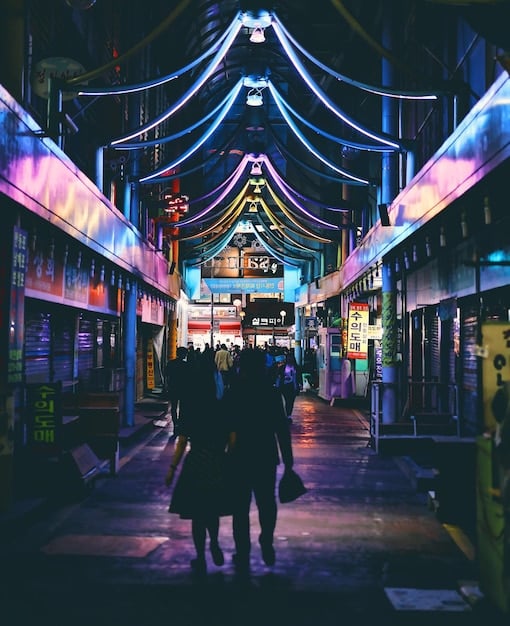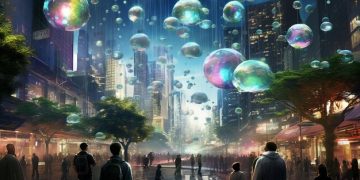The Evolution of J-Drama Production: Modern Techniques & Behind-the-Scenes

The evolution of J-drama production showcases a fascinating shift from traditional methods to modern techniques, impacting everything from storytelling and cinematography to audience engagement, reflecting technological advancements and shifting cultural preferences.
Dive into the fascinating world of Japanese drama production and witness the evolution of J-drama production from its humble beginnings to the cutting-edge techniques employed today.
The Dawn of J-Drama: Laying the Foundation
The initial phases of J-drama were marked by a simpler approach, relying heavily on theatrical conventions and limited technology. These early productions, while constrained by resources, established the storytelling foundations that would later define the genre.
Exploring the historical roots and early influences provides a crucial understanding of how J-dramas have transformed into the sophisticated productions we enjoy today. Let’s examine the pivotal elements that shaped the genesis of J-drama.
Early Influences and Formative Years
The groundwork for J-drama was laid down by traditional Japanese performing arts and early cinematic experiments. These influences shaped the narratives and visual styles, establishing uniquely Japanese themes and aesthetics.
Technological Limitations and Creative Solutions
Limited resources necessitated innovative solutions in early J-drama production. Filmmakers maximized available tools, employing clever camera angles and resourceful editing techniques to bring their stories to life.

Consider these features from J-Drama’s early stages:
- Theatrical Conventions: Early J-dramas borrowed heavily from Kabuki and Noh theater, influencing acting styles and set designs.
- Limited Equipment: Filmmakers creatively worked around technological constraints, telling compelling stories with minimal resources.
- Narrative Focus: Emphasis was placed on character development and intricate plots, compensating for a lack of visual spectacle.
Reflecting on J-drama’s origins provides a profound appreciation for how far the industry has come. These early efforts spotlight the resilience and creativity of pioneers adapting to significant resource constraints.
Technological Advancements: A Paradigm Shift
Technological innovation has revolutionized J-drama, impacting every facet of production from pre-production to post-production. These advancements have broadened the creative canvas, unlocking new opportunities for storytelling and visual sophistication.
Exploring the integration of these technological leaps offers insights into contemporary J-drama’s aesthetic and narrative complexity. Here’s how technology has spurred the evolution.
The Digital Revolution in Filmmaking
The adoption of digital cameras, editing suites, and visual effects software has propelled J-drama into a new era of visual storytelling. These tools enable more intricate and dynamic productions, enhancing the overall viewing experience.
Advancements in Sound and Lighting Technologies
Improvements in sound recording and lighting equipment have elevated the technical quality of J-dramas. Crisp audio and nuanced lighting now contribute significantly to creating immersive and emotionally resonant scenes.
The following reflects notable tech improvements to J-Drama:
- High-Definition Filming: Improved resolution and clarity have heightened the visual impact of J-dramas, bringing finer details to the forefront.
- Advanced Editing Techniques: Non-linear editing systems enable greater flexibility and precision in post-production.
- CGI and VFX: Computer-generated imagery and visual effects expand the range of narratives, enhancing realism and fantasy elements.
Technology continues to propel the capabilities and artistic boundaries of J-drama production. These advances have not only improved technical quality but also enabled deeper engagement with nuanced storytelling.
The Scriptwriting Renaissance: Evolving Narratives
Modern J-dramas highlight increasingly diverse and nuanced themes, mirroring shifts in societal values and audience preferences. Scriptwriting has evolved to tackle complex issues with greater depth and sensitivity.
Analyzing these narrative changes reveals how modern J-dramas engage with their viewers on emotional and intellectual levels. Let’s explore the transforming scriptwriting process.
Exploring Complex Themes and Genre Blending
Contemporary J-dramas often address complex social issues, psychological themes, and moral dilemmas, creating stories that resonate deeply with viewers. Genre blending combines elements from romance, thriller, and science fiction, broadening the appeal.
Character Development and Emotional Depth
Emphasis on character development has led to more authentic and relatable protagonists. The complexity of characters’ emotional journeys enhances the narrative, providing viewers with profound emotional connections.

The following highlights key changes to scriptwriting:
- Social Commentary: J-dramas increasingly reflect and critique societal norms, bringing pressing issues to the forefront.
- Psychological Exploration: Deeper dives into character psychology reveal more about the complexity of human emotions.
- Thematic Diversity: A widening range of themes, including mental health, social justice, and identity, make J-dramas more relevant and relatable.
The renaissance in J-drama scriptwriting reflects a dedication to crafting meaningful stories that cater to a more sophisticated and insightful audience. The narratives increasingly delve into the intricacies of human experience, driving a deeper connection with viewers.
Directing and Cinematography: A Visual Transformation
Directors and cinematographers play pivotal roles in shaping the distinctive look and tone of J-dramas. Emerging trends include innovative camera techniques, unconventional compositions, and dynamic visual storytelling.
Examining the evolution of directing and cinematography illustrates how crucial these roles are in defining J-drama’s aesthetic identity. Here’s a deeper examination of how these elements have been reimagined:
Innovative Camera Techniques and Visual Storytelling
J-drama directors experiment with unconventional camera angles and dynamic shots to augment the narrative. Panning motions, drone shots, and close-ups create visual tension and draw viewers into the story.
The Influence of Lighting and Color Grading
Strategic use of lighting and color grading can significantly alter a scene’s emotional impact. Subtle color palettes and carefully designed lighting schemes enhance the tonal nuances within the storytelling.
Consider the following elements for more on directing and cinematography:
- Dynamic Compositions: Unconventional framing and balanced compositions heighten the visual curiosity and keep viewers engaged.
- Emotional Lighting: Sophisticated use of shadows and lighting evoke varying emotions and enhance the atmosphere.
- Visual Symbolism: Cinematographers incorporate symbolic elements within the visuals to deepen thematic exploration.
The evolution of directing and cinematography has profoundly enhanced the visual language of J-dramas. These elements transform passive viewing into immersive experiences, deeply affecting viewers through thoughtfully crafted visual narratives.
Production Design and Costuming: Creating Authenticity
Production design and costuming are essential in creating believable and visually engaging worlds within J-dramas. Authentic set designs and period-appropriate costumes immerse viewers in the narrative, improving the overall experience.
Understanding the intricacies of production design exposes how details enhance the believability and aesthetic appeal of modern J-dramas. Here’s a glimpse behind the scenes.
The Role of Set Design in Enhancing Realism
Meticulously designed sets establish a sense of time and place, contributing to the authenticity of the story. Attention to architectural detail, interior decorations, and location choices bring the narrative to life.
Costuming as a Narrative Tool
Costumes reflect characters’ personalities, social status, and emotional state. Period-accurate attire or modern fashion choices communicate non-verbally, enriching the storytelling.
The following reflects notable production and costuming points:
- Cultural Accuracy: Authentic representation of cultural details promotes deeper immersion and connection with the story.
- Visual Consistency: Harmonious integration of costumes and set design contributes to a cohesive visual narrative.
- Character Detailing: Subtle costume choices reflect a character’s internal state, contributing to their emotional depth.
Meticulous attention to production design and costuming enriches the visual tapestry of J-dramas. Strategic application of details elevates viewers’ emotional and intellectual engagement, fostering a deeper appreciation for the artistry involved.
Audience Engagement: Interactivity and Social Media
Contemporary J-dramas leverage digital platforms for engaging with audiences, enhancing viewing experiences through interactivity and social media. These interactions enable real-time feedback, shaping both production and audience perceptions.
Exploring how J-dramas boost audience engagement reveals critical aspects of viewer-producer relationships. Here’s more on these dynamics:
Social Media’s Influence on J-Drama Popularity
Social media platforms amplify J-drama popularity through sharing, reviews, and fan communities. Viral clips and hashtags extend the reach, fostering wider interest and discussion.
Interactive Viewing Experiences and Real-Time Feedback
Streaming platforms provide interactive components, such as live chats and polls, enabling real-time audience participation. Direct feedback influences immediate aspects of J-drama storytelling and promotion.
Consider these aspects of audience engagement:
- Fan Communities: Online communities build enduring connections among viewers, extending the viewing experience beyond individual episodes.
- Viral Marketing: Creative use of social media promotes J-dramas through memes, challenges, and behind-the-scenes content.
- Direct Interaction: Producers and actors directly engage fans, fostering a sense of community and commitment.
Increasing audience engagement using digital platforms and social media reshapes how J-dramas are consumed and appreciated. Interactive features and communal viewing experiences deepen emotional commitments and broaden the genre’s appeal globally.
| Key Aspect | Brief Description |
|---|---|
| 🎬 Early Influences | Rooted in theater, limited tech fostered creative storytelling. |
| ⚙️ Tech Advances | Digital tools enhanced visuals, sound, and overall production. |
| ✍️ Script Renewal | Themes became complex, genres blended, characters deepened. |
| 📱 Audience Engagement | Social media and interactive platforms deepened viewer connection. |
Frequently Asked Questions
▼
Early J-dramas were defined by their roots in theater and cinema, relying on simplified production methodologies and narrative focus. Cost constraints influenced the acting techniques and set designs that characterized the genre’s foundations.
▼
Technology has revolutionized J-drama with the introduction of advanced camera systems, visual editing software, and sound equipment. These developments have enabled greater creative freedom, enhanced visual experiences, and more immersive narratives.
▼
Modern J-dramas explore social commentary themes, psychological intricacies, interpersonal relationships, and diverse cultural aspects. These narratives focus on reflective and complex storytelling, resonating with modern audiences seeking authenticity and depth.
▼
J-dramas now frequently integrate social media platforms and interactive components to enhance audience engagement. This involves real-time interaction, direct feedback from viewers, and viral marketing efforts that reinforce the close-knit connection between fans and the shows.
▼
Cinematography has evolved dramatically, now incorporating a range of visual effects, dynamic camera angles, and innovative lighting strategies. These tools help create nuanced storytelling, enhancing emotions and visual appeal, while drawing viewers deeper into unfolding narratives.
Conclusion
The journey of J-drama from its early forms rooted in theater to its current digital and interactive presence reflects a vibrant, evolutionary path. Influenced by technological advancements, scriptwriting renaissance, visual transformations, meticulous production design, and enhanced audience engagement, J-drama continues to captivate global audiences with intricate storytelling and immersive experiences.





